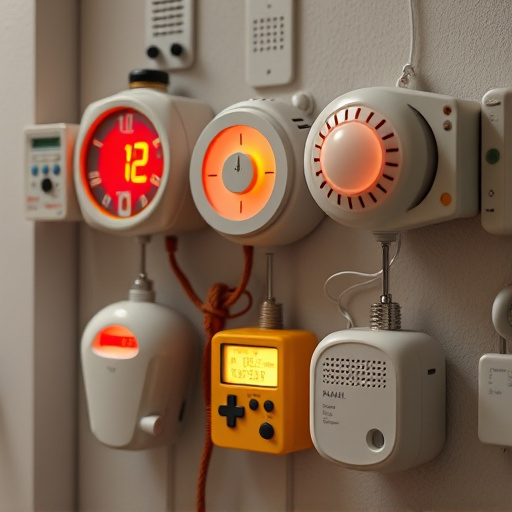Portable panic buttons offer peace of mind with loud sirens, LED lights, and GPS tracking, ideal for solo travelers or remote residents. Monitoring services enhance utility by providing real-time tracking, immediate support, automated alerts, and continuous location updates. When choosing a device, consider the Personal Alarm Distance Range (300-1500 ft), as it ensures prompt assistance in emergencies. Prioritize security and privacy by understanding data collection practices and the specified distance range. Compare options to inform decisions for enhanced safety and protection.
In today’s world, personal safety is paramount. Portable panic buttons with monitoring services offer a revolutionary solution for individuals seeking peace of mind. This comprehensive guide explores the features and benefits of these compact devices, delving into real-time tracking capabilities and security measures. We compare various models based on their distance range, ensuring you’re prepared for emergencies anywhere. Discover how these tools enhance personal safety and provide instant support when it matters most.
- Understanding Portable Panic Buttons: Features and Benefits
- Monitoring Services: Real-Time Tracking and Support
- Distance Range: What to Expect from Different Models
- Security and Privacy: Ensuring Safe Use of Panic Buttons
Understanding Portable Panic Buttons: Features and Benefits
Portable panic buttons are compact, personal alarms designed for emergency situations, offering a range of features that provide users with peace of mind. These devices typically include a loud siren and LED flashing light to attract attention quickly. Many models also feature GPS tracking, allowing authorities to pinpoint the user’s location in case of distress.
The key benefit lies in their portability, making them convenient for individuals who travel alone or those living in remote areas. The personal alarm distance range varies among devices; some have a range of up to 500 meters (1640 feet), ensuring fast response times when pressed. This technology is a game-changer for safety, empowering users with an easy-to-use tool to signal for help when facing emergencies.
Monitoring Services: Real-Time Tracking and Support
Monitoring services play a pivotal role in the effectiveness of portable panic buttons, offering real-time tracking and immediate support. Unlike traditional alarm systems that rely on loud sounds to deter threats, these buttons transmit signals to a central monitoring station when activated. This enables operators to pinpoint the user’s location within a specified personal alarm distance range, ensuring swift response times.
When comparing different portable panic button devices, assessing their respective distance ranges is crucial. A wider range ensures better coverage and peace of mind, especially in large or remote areas. Advanced monitoring services also provide additional features like automated alerts to emergency contacts, integration with existing security systems, and even GPS tracking for continuous location updates, enhancing overall safety and security.
Distance Range: What to Expect from Different Models
When considering a portable panic button with monitoring service, one of the key factors to evaluate is the personal alarm distance range. This specification varies significantly across different models, and understanding what to expect can help you make an informed decision based on your needs.
The typical range for these devices falls between 300 and 1500 feet (91 to 457 meters). Lower-end models might offer a more limited reach of around 300 to 500 feet, while pricier options can extend up to 1500 feet or more. This range dictates the effectiveness of the alarm in an emergency situation, especially when outdoors or in large spaces. A wider distance range ensures better coverage and peace of mind, allowing for help to arrive promptly even at greater separations.
Security and Privacy: Ensuring Safe Use of Panic Buttons
Security and privacy are paramount considerations when using portable panic buttons, especially with monitoring services involved. These devices offer vital personal safety features, but users must ensure their responsible use to maintain a secure environment. One key aspect is understanding and adhering to the specified personal alarm distance range provided by different manufacturers. This range determines the effectiveness of the device, ensuring help arrives promptly when activated within the optimal range.
Privacy concerns arise from the constant connectivity offered by monitoring services. Users should be aware of data collection practices, knowing exactly what information is shared and with whom. Transparent policies on data security and encryption methods are essential to protect personal details. Regularly reviewing and updating privacy settings can also help maintain control over one’s digital footprint, especially when relying on these devices for safety in public spaces or while traveling.
Portable panic buttons with monitoring services offer a powerful personal safety net, especially for individuals who frequently travel or spend time alone. By comparing different models based on their features, benefits, distance range (a crucial aspect to consider), and security measures, users can make informed decisions to choose the best-suited device for their needs. These devices provide peace of mind by offering real-time tracking and rapid support, ensuring immediate assistance during emergencies. Remember that selecting a panic button involves understanding its limitations, especially in terms of distance range, while prioritizing your safety and privacy.
